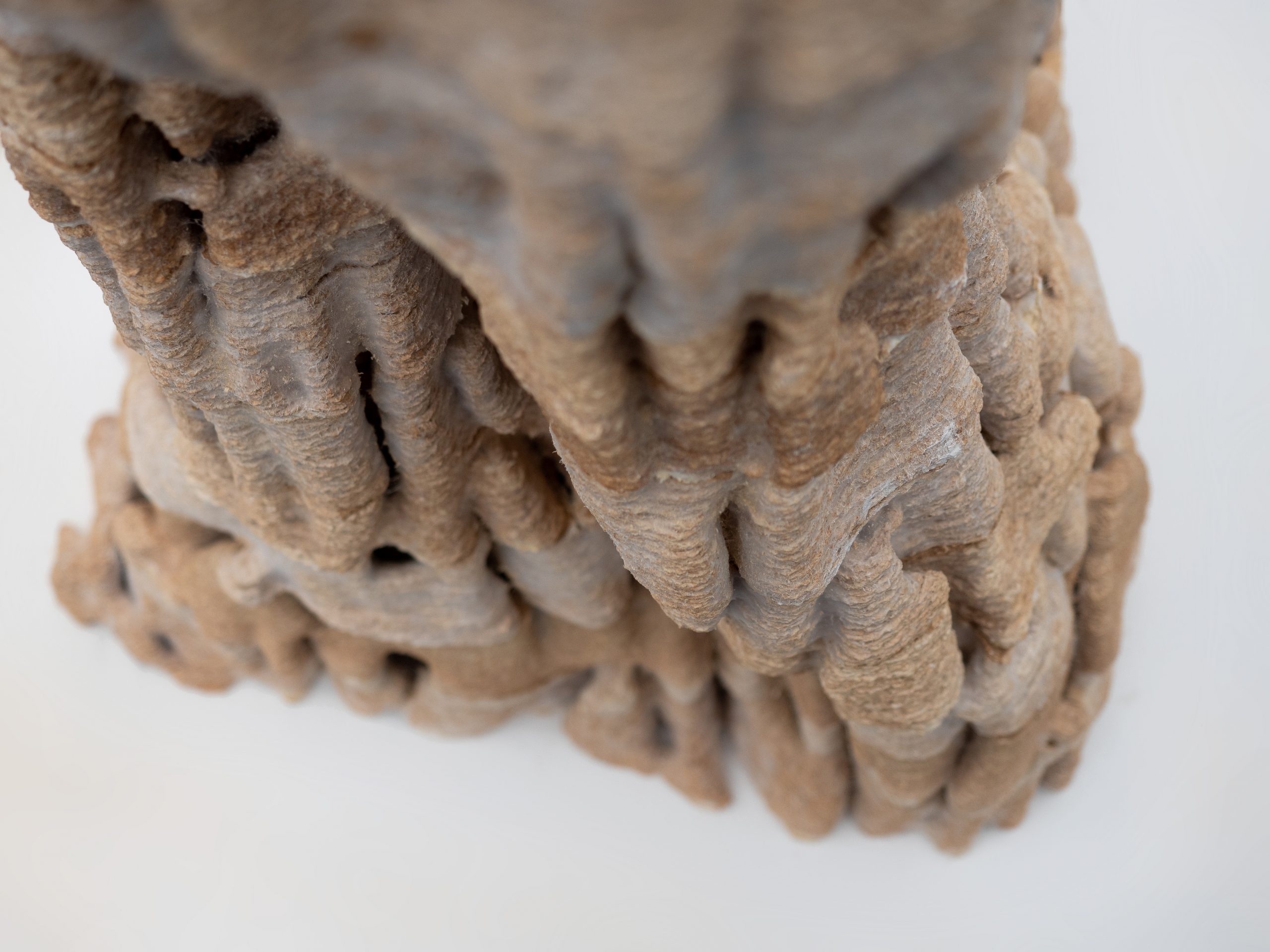Protomycokion

Useful information
- Team members
- Ana Goidea David Andréen
- Country
- Sweden
- Keywords
- 3d printing architecture biocomposite biomaterial biofabrication fungi microorganisms circular production computational design mass customization digital fabrication
Short Description
3d printed column from biotransformed recycled fibres
Detailed Description
Inspired by processes of growth and construction in nature, Protomycokion is a system where renewable biomass is used to fabricate sustainable building components. Fibrous by-products (recycled newspapers, agricultural residues and construction waste) are inoculated with a fungus that transforms the waste into a resilient construction material. Live pulp is 3d printed into a column that is algorithmically designed to incorporate both the requirements of the fungus and the humans end users. The haptic and acoustic properties of the material are defined and soft; both gentle and stimulating at the same time. When combined with freeform expressions derived from the design and fabrication technology, extraordinary spaces can be created. Employing 3d printing and computational design, we move into a mass-customization era, where homes can be as expressive and varied as the people that inhabit them, responsive to diverse contexts, changes of use, and cultural preferences.
Project Details
- Does your design take social and cultural challenges and human wellbeing into consideration?
One of the defining challenges of today is to achieve fair distribution of resources and possibilities in a time when economic and industrial growth in its current form is proving unsustainable. This project enables a production mode where function, structures, and production logic are encoded digitally and where the raw materials are grown locally from flora native and suitable to the particular region. These processes can be available to any community irrespective of location and physical infrastructure without relying on carbon intense factories, mining operations, and transportation. The algorithmic nature of the design process means that global distribution does not require conformity and standardization, but enables adaptive design which relates to local contexts both cultural and functional.
- Does your design support sustainable production, embodying circular or regenerative design practices?
Fungi are the archetype of circularity; they are the major decomposers of our world, preparing waste to be reintegrated into new organisms. In this project the fungi are incorporated in this role, transforming rather than decomposing, creating new material from what was previously unusable in our society. Through the micro-scale chemical transformation enabled by the fungus, the usual limit of fiber re-use can be overcome and true circularity be achieved. Because the fungus can adapt to variable feedstocks, the project does not force farms of uniform mono-cultures but can depend on locally distinct and highly varied modes of production: recycled paper products, sawdust, grass, wheat straw, rice husks - even old buildings can be recycled in the process.
- Does your design use principles of distribution and open source?
Current paradigms of building construction rely on highly integrated and standardized systems with corporate control of the full value chain. Such standardization is followed by industrially manufactured materials that require uniformity and consistency, and as a result pose high barriers of entry that exclude smaller actors or community-based initiatives. By the use of biological transformation processes it is possible to create highly performative materials from a wide range of raw materials that can vary between locations and communities: recycled paper, agricultural waste or forestry by-products. When combined with algorithmic design processes that can be distributed and developed through open source principles, the resulting architecture can revive some of the most valuable lost aspects of traditional architecture, through new forms: uniquely adapted to local climate and resources, and born through an ongoing interaction with local culture and expression.
The project outcomes, in the form of recipes and protocols, have been made available to date through an open access conference proceedings (Fabricate2020), which to date has been downloaded over 4,000 times.
- Does your design promote awareness of responsible design and consumption?
Through the use of biological agents and the imprint they leave on the aesthetics, the column challenges our relationship to nature and the sharp boundaries we draw to form our living spaces. Do desirable products/spaces have to still promote sleek, smooth, shiny ideals of eternal use, that become waste when not spotless anymore? Perhaps we can instead see joy in porous and richly textured surfaces, that change with time and use to eventually break down into nature.
Images


